




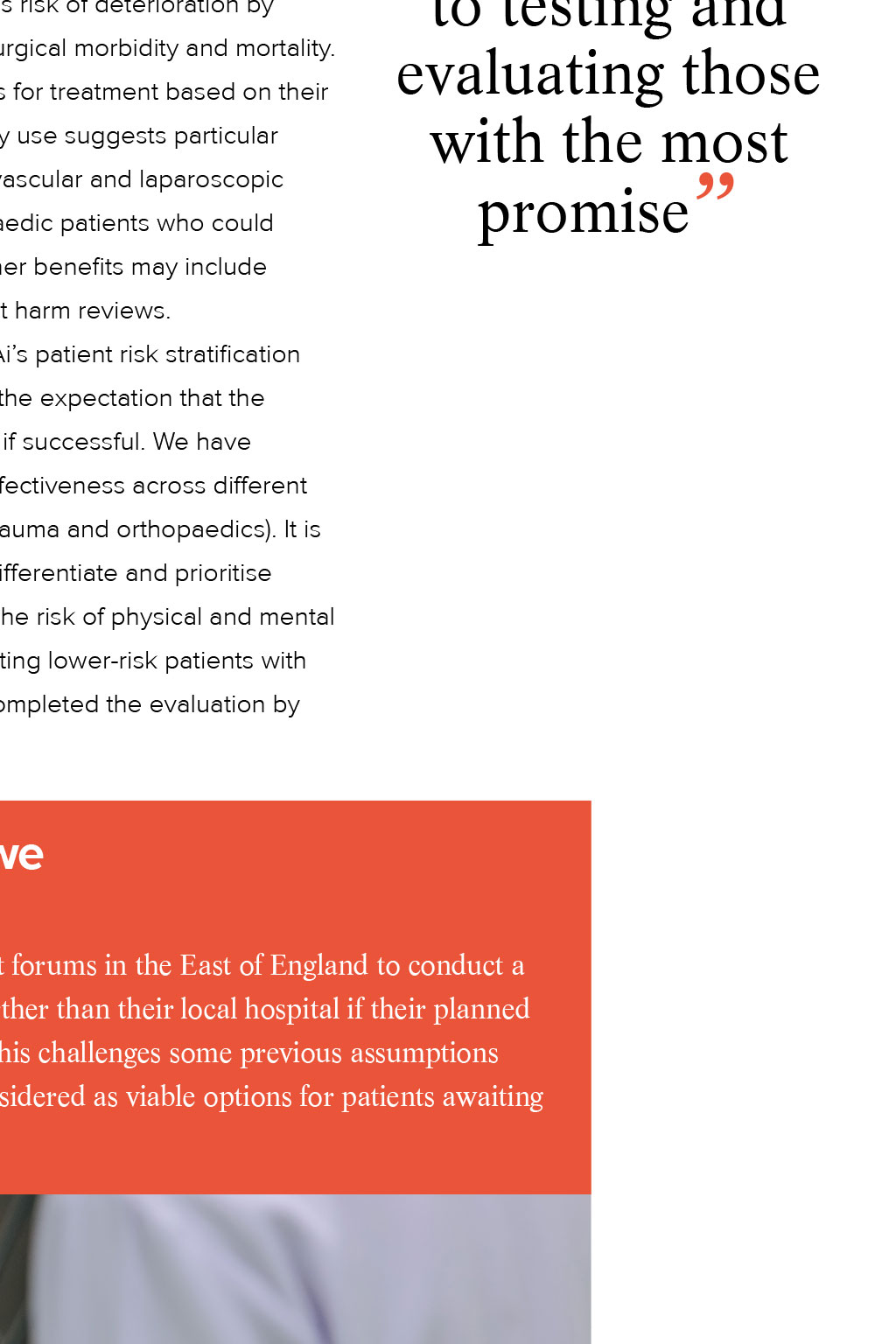
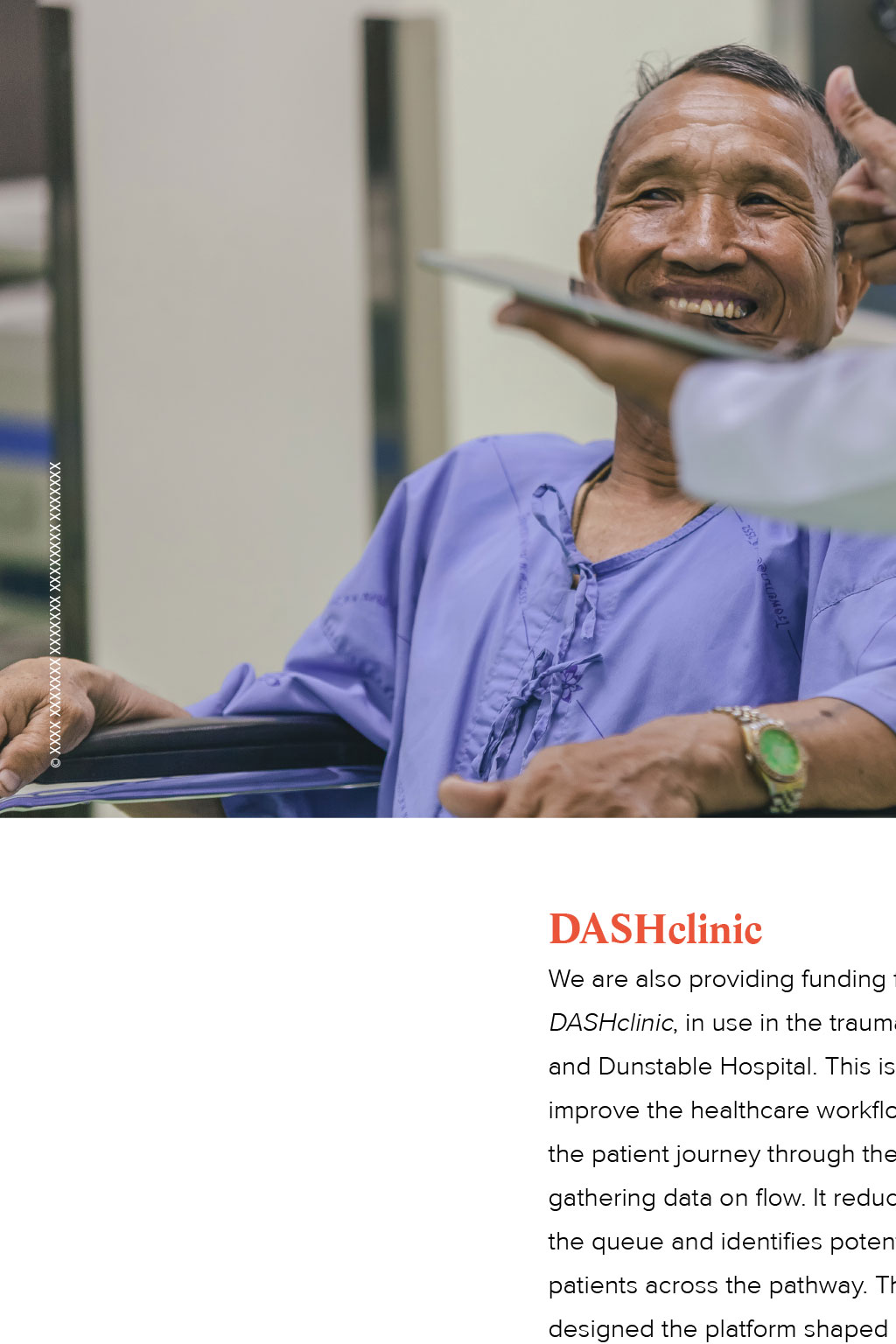
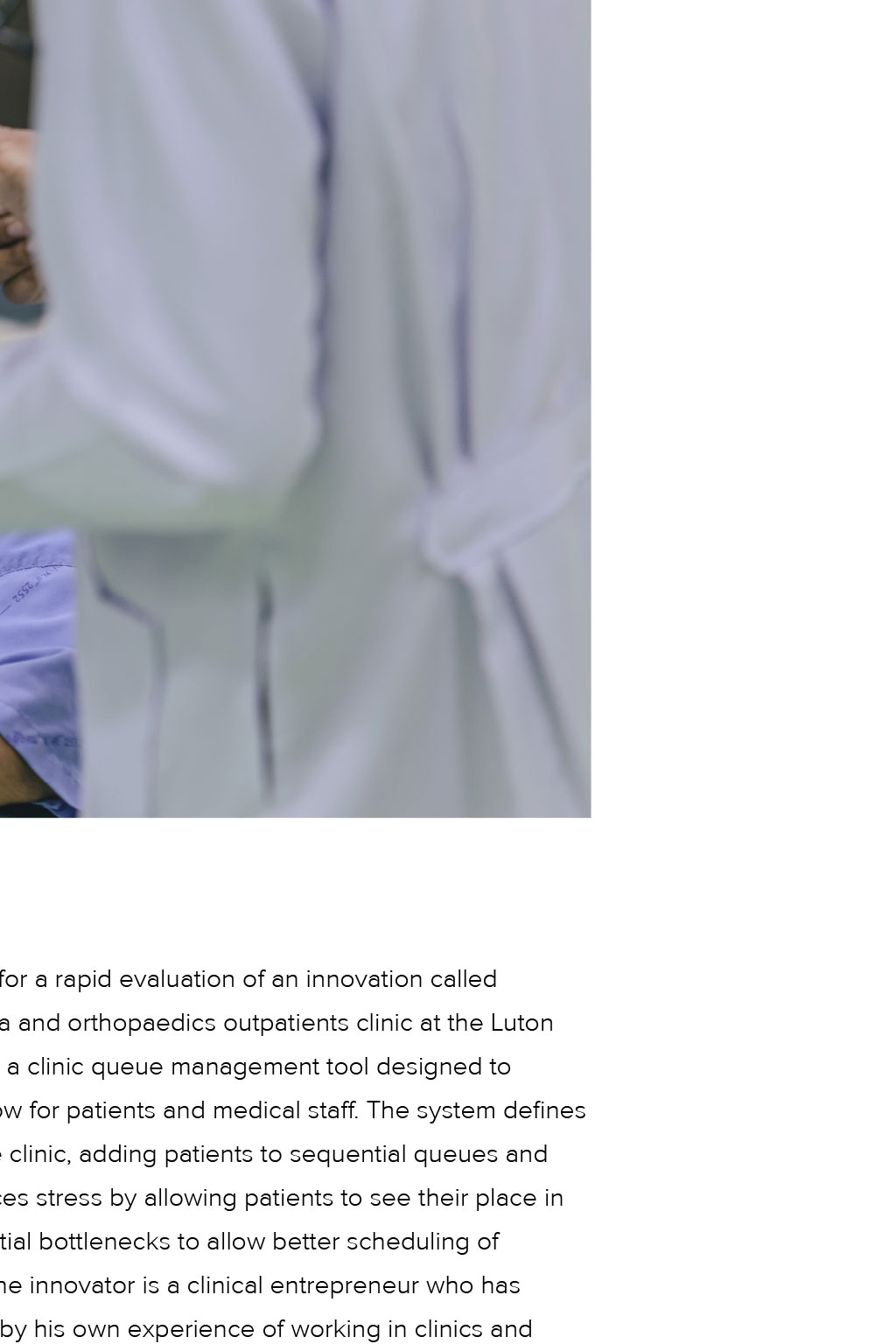
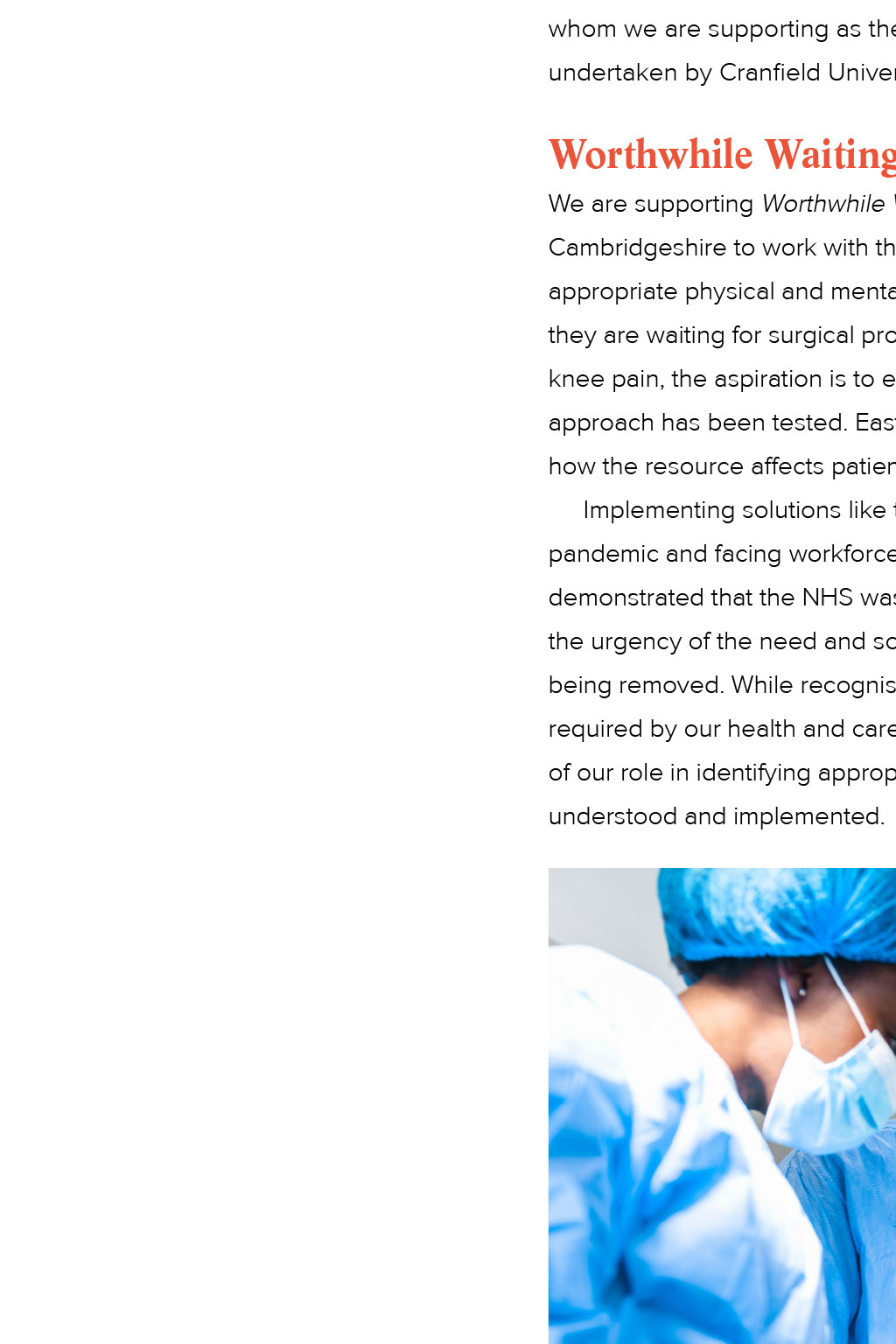
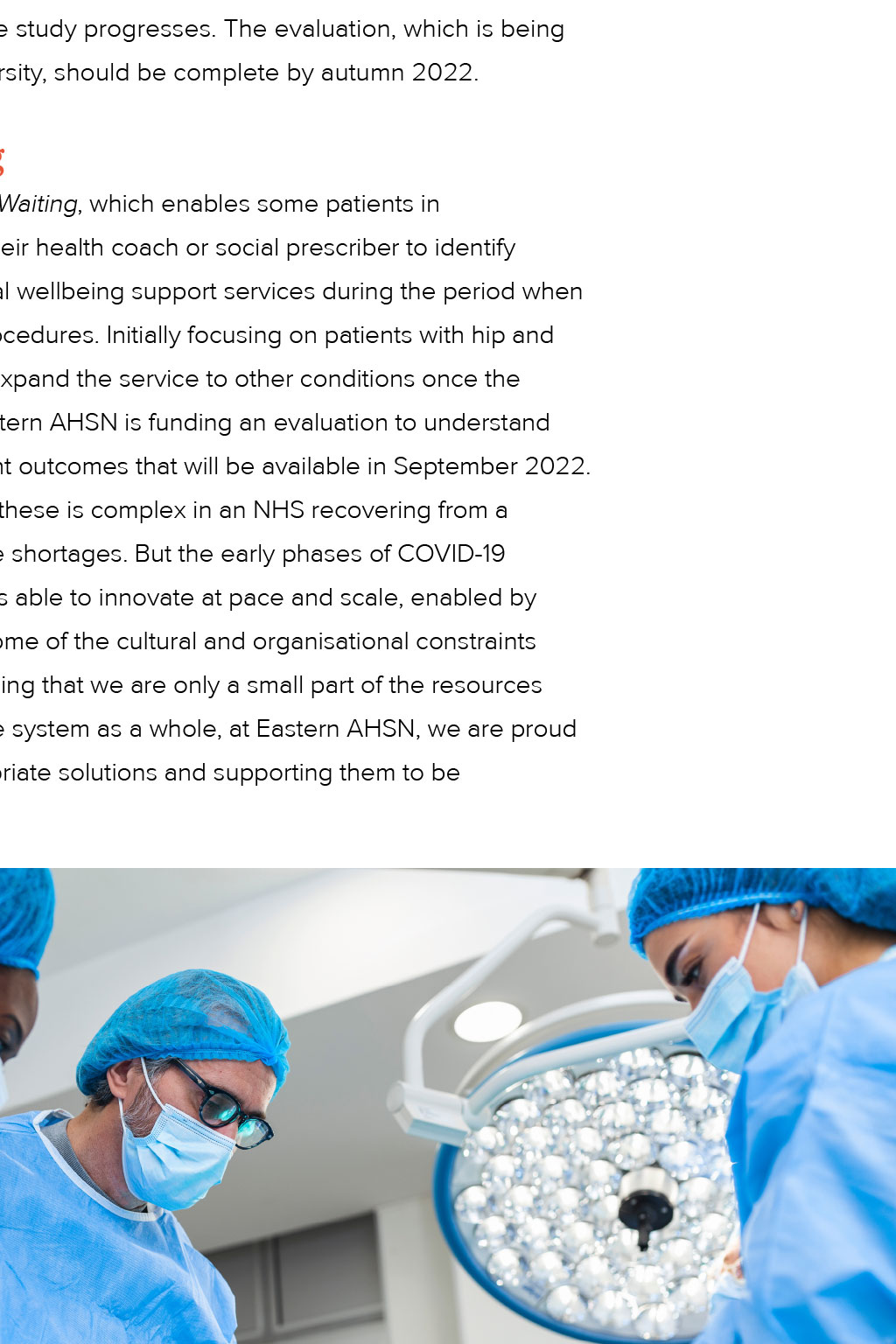

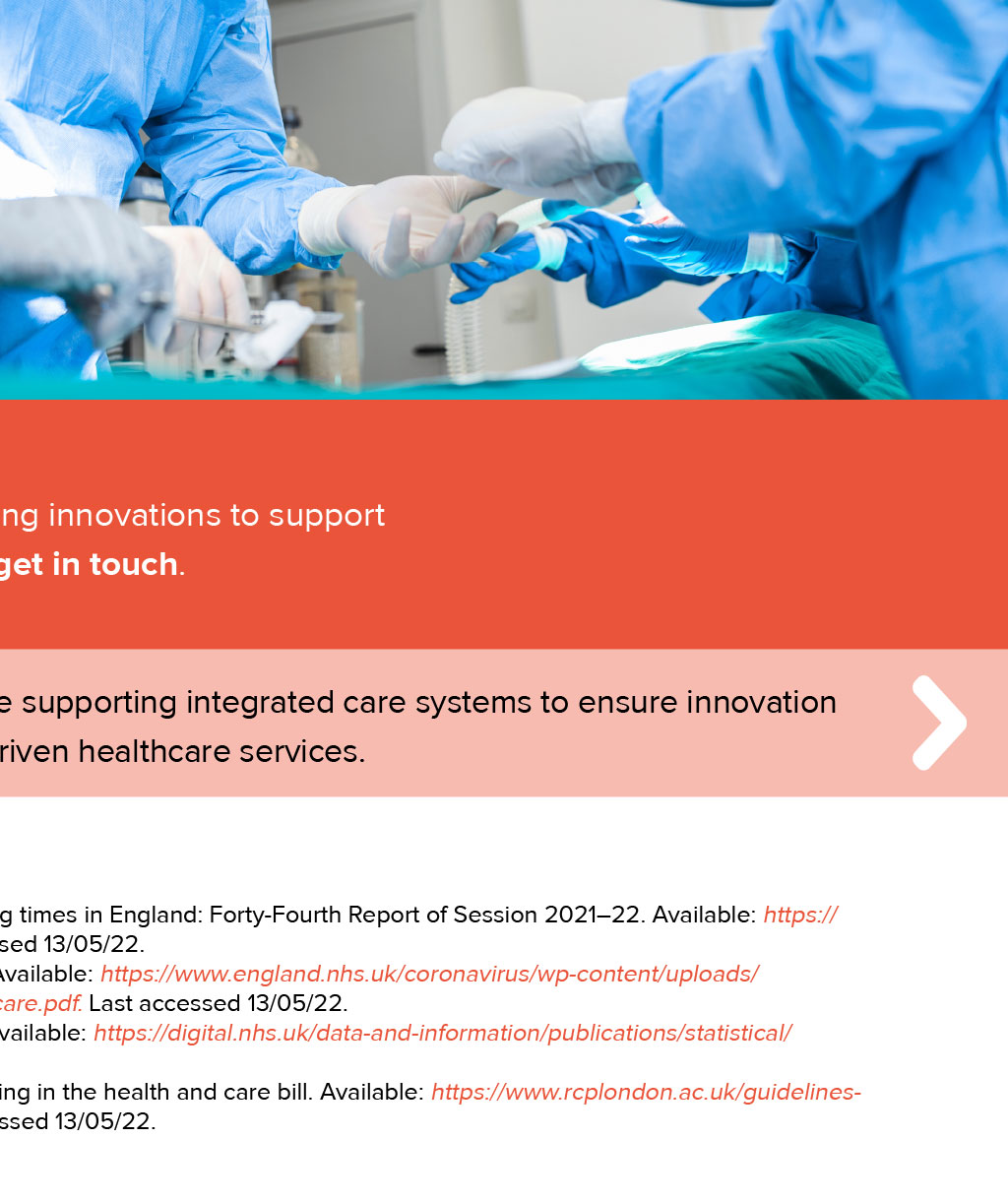













Waiting lists Supporting the elective recovery Piers Ricketts, Chief Executive at Eastern AHSN, explains how innovative tools could be the solution to easing pressure on elective services following the COVID-19 pandemic R ecent data showed that there were more than six million people awaiting a procedure on the NHS1,2. This is the largest number since records began. The number may well be growing, as the millions of missing referrals arising as a result of the pandemic start to present and more people come forward for treatment. This continues to be a major area of concern due to its potential impact on the clinical outcomes for patients on the list. The concerns include increased patient anxiety and mental stress and potentially a risk of increased morbidity that could result in otherwise avoidable emergency admissions. Waiting for treatment can also prevent continued employment and will often produce an adverse impact on the patients health and wellbeing more generally. There are no easy answers here. Hospitals ability to get through their wait lists continues to be hampered by the infection and control procedures needed to contain outbreaks of COVID-19. At the same time, significant numbers of staff continue to be absent from work because they are themselves infected with the virus. And all this comes at a time of record numbers of staff vacancies3,4. In the absence of wholesale solutions, there are nonetheless numerous smaller- scale initiatives which, taken together, can help our health and care systems to make the most of their finite resources while reducing the risk of physical and mental deterioration experienced by patients as they wait for their procedure. At Eastern AHSN, we are constantly looking for solutions that can support services in our region and across the wider NHS and are committed to testing and evaluating those with the most promise. In 2021/22, we have been working with integrated care systems and providers in our region to better understand where innovation could best support with managing capacity and minimising the consequences of long waiting lists. An example of this is our support of three innovations this year designed to improve the experience for one of the largest patient groups those awaiting orthopaedic procedures. C2-Ais elective care Patient Tracking List Triage system uses an AI-driven decision support tool to assess each wait list patients risk of deterioration by assessing their data against a proven risk index of surgical morbidity and mortality. The system enables clinicians to re-prioritise patients for treatment based on their individual risk of complication and deterioration. Early use suggests particular benefits in assessing the risk of patients waiting for vascular and laparoscopic colon surgery, and also identifying lower risk orthopaedic patients who could We are constantly looking for solutions that can support services in our region and across the wider NHS and committed to testing and evaluating those with the most promise helpfully be transferred to elective surgery hubs. Other benefits may include improved capacity planning and the ability to support harm reviews. Eastern AHSN supported the introduction of C2-Ais patient risk stratification system at Colchester hospital in January 2022, with the expectation that the platform would also be rolled out to Ipswich hospital if successful. We have commissioned a formal evaluation of the systems effectiveness across different surgical specialties (general surgery, gynaecology, trauma and orthopaedics). It is hoped that the system will enable clinical teams to differentiate and prioritise patients to be treated in a sequence that minimises the risk of physical and mental deterioration while on the wait list, while also supporting lower-risk patients with prehabilitation and conditioning. We hope to have completed the evaluation by January 2023. Understanding patients views on how we manage capacity in secondary care XXXX XXXXXXX XXXXXXX XXXXXXXX XXXXXXX We partnered with the local NHS and patient and public engagement forums in the East of England to conduct a survey that suggested that most citizens would be willing to travel further than their local hospital if their planned procedure could be performed earlier or if it would help the NHS. This challenges some previous assumptions and provides evidence that initiatives, including travel, should be considered as viable options for patients awaiting treatment on lengthy wait lists. DASHclinic We are also providing funding for a rapid evaluation of an innovation called DASHclinic, in use in the trauma and orthopaedics outpatients clinic at the Luton and Dunstable Hospital. This is a clinic queue management tool designed to improve the healthcare workflow for patients and medical staff. The system defines the patient journey through the clinic, adding patients to sequential queues and gathering data on flow. It reduces stress by allowing patients to see their place in the queue and identifies potential bottlenecks to allow better scheduling of patients across the pathway. The innovator is a clinical entrepreneur who has designed the platform shaped by his own experience of working in clinics and whom we are supporting as the study progresses. The evaluation, which is being undertaken by Cranfield University, should be complete by autumn 2022. Worthwhile Waiting We are supporting Worthwhile Waiting, which enables some patients in Cambridgeshire to work with their health coach or social prescriber to identify appropriate physical and mental wellbeing support services during the period when they are waiting for surgical procedures. Initially focusing on patients with hip and knee pain, the aspiration is to expand the service to other conditions once the approach has been tested. Eastern AHSN is funding an evaluation to understand how the resource affects patient outcomes that will be available in September 2022. Implementing solutions like these is complex in an NHS recovering from a pandemic and facing workforce shortages. But the early phases of COVID-19 demonstrated that the NHS was able to innovate at pace and scale, enabled by the urgency of the need and some of the cultural and organisational constraints being removed. While recognising that we are only a small part of the resources required by our health and care system as a whole, at Eastern AHSN, we are proud of our role in identifying appropriate solutions and supporting them to be understood and implemented. Share this article Return to the contents page Get involved If you would like help finding innovations to support health and care services, get in touch. Up next: Read how we are supporting integrated care systems to ensure innovation is at the centre of patient-driven healthcare services. References House of Commons Committee of Public Accounts. (2022). NHS backlogs and waiting times in England: Forty-Fourth Report of Session 202122. Available: https://committees.parliament.uk/publications/9266/documents/160332/default/. Last accessed 13/05/22. 2 NHS England and NHS Improvement. (2022). Tackling the backlog of elective care. Available: https://www.england.nhs.uk/coronavirus/wp-content/uploads/ sites/52/2022/02/C1466-delivery-plan-for-tackling-the-covid-19-backlog-of-elective-care.pdf. Last accessed 13/05/22. 3 NHS Digital. (2022). NHS Vacancy Statistics (and previous NHS Vacancies Survey). Available: https://digital.nhs.uk/data-and-information/publications/statistical/nhs-vacancies-survey. Last accessed 13/05/22. 4 Royal College of Physicians. (2022). Strength in Numbers - stronger workforce planning in the health and care bill. Available: https://www.rcplondon.ac.uk/guidelinespolicy/strength-numbers-stronger-workforce-planning-health-and-care-bill. Last accessed 13/05/22. 1